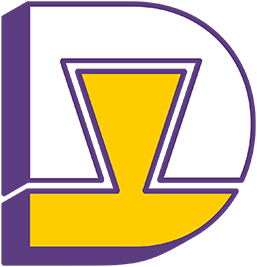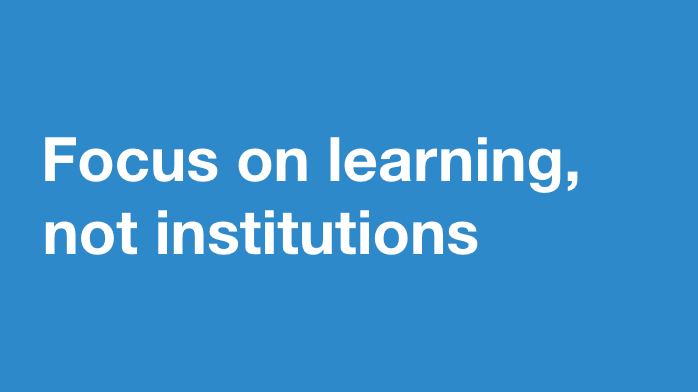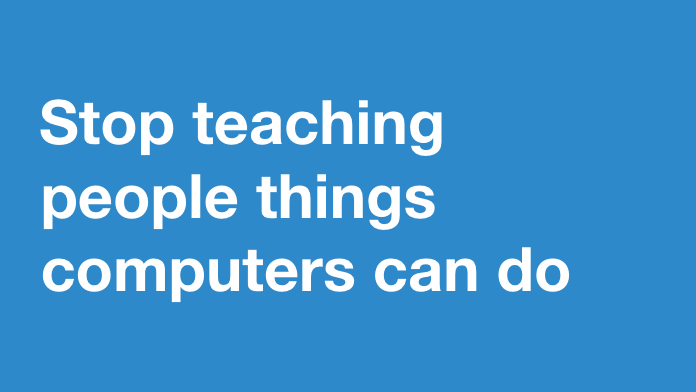Resources Index
-
Design Ventura 2022-23 Webinars
Design Ventura webinars are for teachers and students. They feature leading designers speaking about their work and offering top tips for each stage of the Design Ventura project. You can watch all four webinars from this year’s programme below:
Webinar 1: User Research and Audiences with Designer, Imran Nazerali.
Webinar 2: Sustainable Materials with Maria Giovanna Sandrini from Econyl.
Webinar 3: Business of Design with Alex Asomuyide, Head of UX Credit Risk at Deutsche Bank.
Webinar 4: Creative Process with Yamuna Forzani
-
Design Ventura 2021-22 Industry Insights Online Event
We are pleased to announce the panel of design and business professionals for our online Industry Insights event taking place on the 12 January 2022 5-6pm. You can watch the recording of this event below:
The panel was made up of design and business professionals, who spoke about what they do for a living, how they got where they are and how they use creativity in their jobs, to give students an insight into the different careers in design and business.
You can learn more about each panellist, in alphabetical order by surname, below:
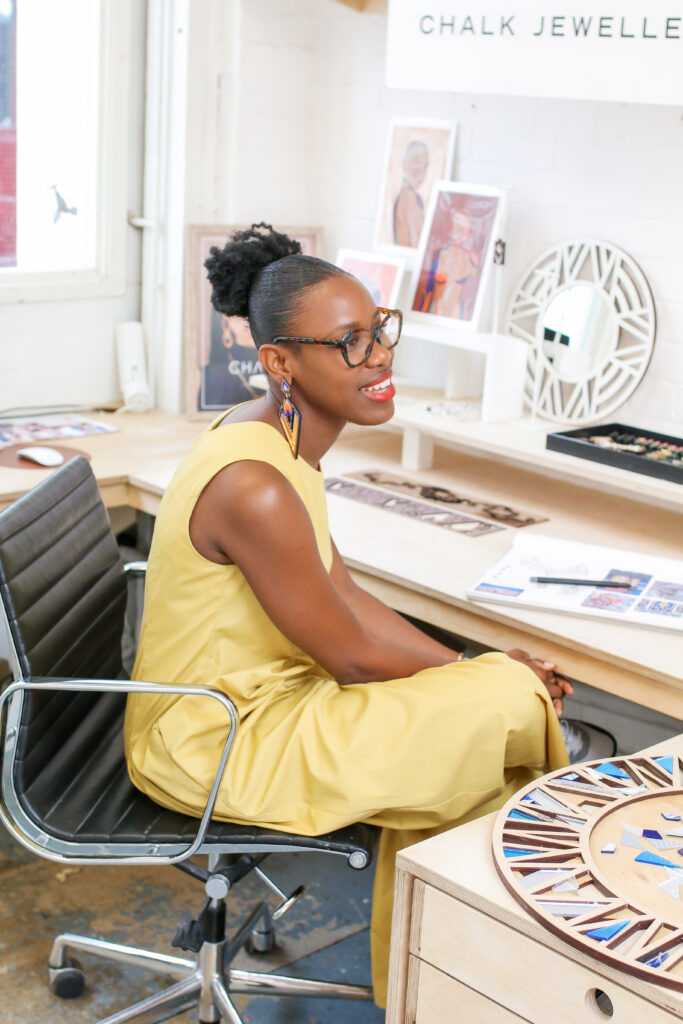
Malaika Carr
www.thechalkhouse.comChalk is a London based design studio run by architect Malaika who creates unusual, geometric jewellery.
Chalk is influenced by architectural elements, everyday objects and bold colourful cultural patterns. Founder Malaika established her jewellery line while studying architecture at the University of Westminster. Here she made numerous intricate models using the laser cutting machine; she started to use the same process to make her own jewellery which later became the label. Since graduation she has continued to make her own pieces and the brand has developed to include their own e-commerce shop as well as supplying a number of exciting stockists around the world.

Richard Hayes
www.playlenz.comRichard is founder of Heayes Design and Playlenz which are game and toy development and invention studios.
Having worked for over 30 years in product design with the majority spent working in the play industry. Richard was Design Director for games at Hasbro looking after brands such as Monopoly, Cluedo, Connect 4 and Trivial Pursuit as well as working on brands such as Playdoh, Star Wars and Marvel.
Most of the work today involves creating and developing new play concepts as well as inventing and licensing new concepts to global toy and game companies.
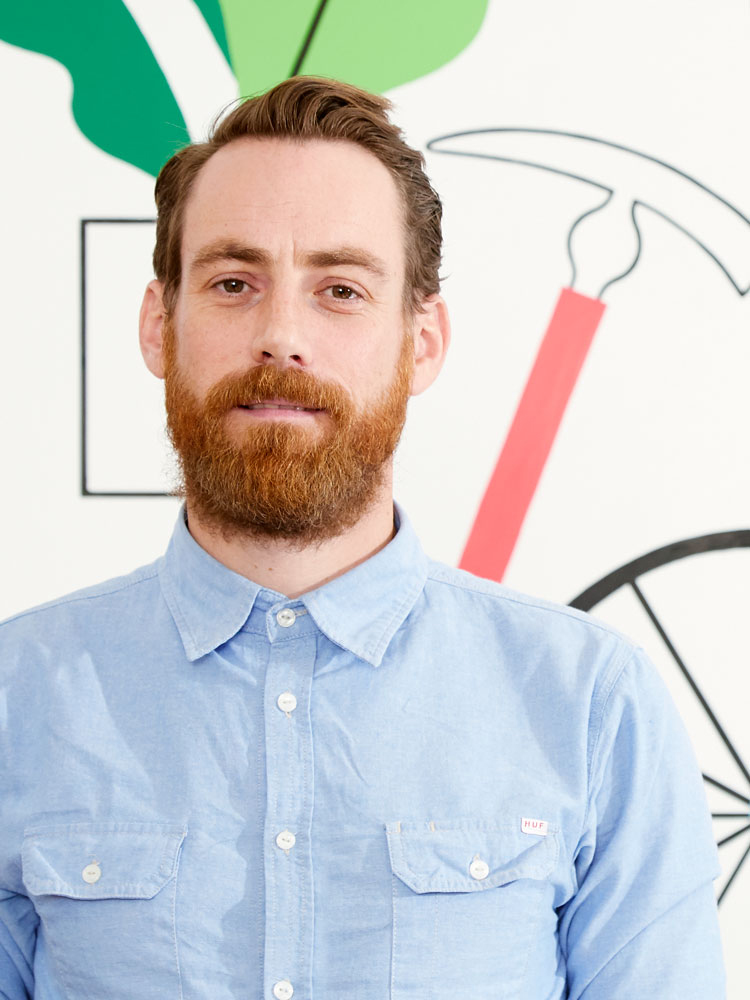
Huw James
www.studiotdh.comHuw has 20 years’ experience in the creative industries, working at design agencies in England and Australia before starting his own studio, Tom, Dick & Harry, in his home city of Leeds.
Huw uses design thinking and a human-centred approach to solve creative problems in branding and design. He is a Fellow of the RSA and is studying an MBA at the University of Manchester, exploring the intersection of creativity and business as a force for good.

Sourav Mishra
www.db.comSourav is a Product Manager in the Technology, Data and Innovation division of Deutsche Bank. He is a Capability Lead who partners with business colleagues, technology architects and developers to identify innovative solutions.
Sourav has a particular focus on Risk Calculation and Operations and uses the latest big data technologies to solve complex high volume challenges. He has been with Deutsche Bank since 2010 and has worked on numerous projects across the Risk Management space.

Ling Tan
www.lingql.comLing is a designer and artist working within the field of social engagement, technology and citizen participation. Originally trained as an architect, her work explores citizens’ interaction with the built environment and our collective agency and responsibility in tackling complex issues surrounding our cities. She works with diverse communities in helping them make sense of their environment, express opinions in a playful and performative way, and collectively address issues ranging from public safety, air quality to climate change using technology and participation methodologies.
-
An introduction to branding and marketing from Make It Clear
Branding and marketing your idea, where to begin?
When creating a business or launching a new product, one of the first things to consider is branding and marketing.
– Branding is who you are and what you look like
– Marketing is how you increase people’s awareness of who you are and how you sell to your target audience.
Branding and marketing have to work together so your product looks and talks to its audience in the same way and sells well!
What is branding?
To begin creating your brand, you must first ask yourself and your team a few questions to understand what your brand is. The questions below are a great place to begin:
- Why did you create your product?
- What makes your product different?
- What do you want people to think of when they hear your product name?
- What feelings/reactions do you want people to have when they think about your product?
The typical parts of a brand are:
- The brand identity: This includes things like your logo, colours and how you use things like photography or illustrations
- Brand values: The things you really care about, take a look at the Make it Clear brand values on this video we created here
- Brand positioning: This shows why your product is different and better than the others
- The brand tone of voice: How you talk to the people that will buy your product
Your branding will establish what people will expect from your product. Knowing what you want to represent in your brand, can guide your marketing.
What is marketing?
Marketing refers to methods used to increase awareness of your product among your target audience, through messaging and visuals. Marketing can become complicated so start by focusing on the following:
– What you want to say and how you want to say it
– How you can reach the people who will want to buy your product
(For example, what social media platforms do your target audience use, or would it be better to just drop a leaflet through a door?)
Chicken or the egg, branding or marketing – which comes first?
Because branding is who you are, it must come first. Before creating your marketing messaging and visuals, you must first decide who your brand is so that you know what you are communicating.
Conclusion
When it comes to building a great brand and marketing plan, it’s all about creating something that works best for your unique product. Sometimes things may not go as planned but the important thing is to try new ideas. So be brave and good luck with branding and marketing your product for the Design Ventura competition!
-
Design Ventura Summit Adventures
The Design Ventura summit “Design: the problem and the solution” was held on 29 March 2017. Its purpose was to bring together educators, designers, cultural providers and policy makers to discuss how they can ensure that young people are developing creativity, design thinking and employability skills to prepare them for future success.
The following extract is by Sarah Campbell, Head of Learning Programmes at the Victoria and Albert Museum and her take on the issues discussed.
Last week, the Design Museum hosted a one-day event as part of their Design Ventura(DV) programme, a ‘design and enterprise challenge for students in years 9, 10 and 11, supported by industry professionals’. The museum invited ‘DV stakeholders’ to participate in a series of talks and workshops exploring the following topic: ‘Design: the problem and the solution (and the imperative for 21C design education)’. It was a fascinating day, not least because a large majority of the audience didn’t work in museums or galleries. The delegates were predominantly teachers and designers, and we talked a lot about how their worlds intersect. The subjects we covered included: improving the relationship between education and industry; access to tech training for teachers; the rising trend of ‘design entrepreneurship’; and the skills that young people need for future employment. For this post, I’ve compiled some of my favourite interesting bits from the day – not an easy task as the whole day was made up of interesting bits – if the Design Ventura Summit had been a chocolate-chip cookie, it would have been made entirely of chocolate.
The Summit was particularly timely too. The day before, the new Chair of Arts Council England, Nick Serota, announced a new commission that will identify how young people benefit from an arts education and strategies for improving current provision. Hopefully, they will build on the myriad of existing reports on the subject, not least ImagiNation: the value of cultural learning, commissioned by the Cultural Learning Alliance and published only a few months ago. The Summit also coincided with the day that the UK Government triggered Article 50, marking the official beginning of divorce proceedings from the European Union. This particular cloud cast quite a long shadow over the event, and the potential negative impact of Brexit on the creative industries was raised a few times. And finally, as I was eating my breakfast earlier that morning and listening to the radio, I heard the news that UK schools are working with ever-diminishing budgets which will result in £3 billion cuts by 2019/20. My first thoughts were with teachers and how grim the work of head teachers will be to balance the books. My second thoughts were, naturally, concerned with museum and gallery education. I suspect school trips will be the first item cut from school budgets (who can blame them?) and this will leave our current model of schools’ provision, focused on site visits, high and dry. It doesn’t matter how great our museum learning programmes are, they ain’t worth much if schools can’t afford to get to us.
With all of these issues swirling around in the background, it was useful to take a design perspective on the confluence of education, policy, and the creative industries. NESTA have been very active in this area and have produced a number of useful reports, including:
- The Fusion Effect (2016): this is NESTA’s take on the STEAM agenda, looking at how the arts and sciences can work together more effectively;
- Creativity Vs Robots (2015): how can anyone resist a title like that? This report looks at the future of jobs and what aspects of work are likely to become automated. A recent Guardian article, ‘Science classes won’t future-proof our children. But dance might’, made reference to PricewaterhouseCooper’s prediction that 30% of British jobs will be lost to automation by the 2030s. Fortunately, artificial intelligence still can’t compete with our human creative capacity, so we’ll remain one step ahead of C3PO for a bit longer.
- Solved! Making the Case for Collaborative Problem-Solving (2017): another title that speaks for itself. ‘Problem-solving’ was definitely one of the day’s key words: it was used as a shorthand definition of design; and it was also name-checked as a 21st century core competency, an attribute valued by employers across a range of industries.
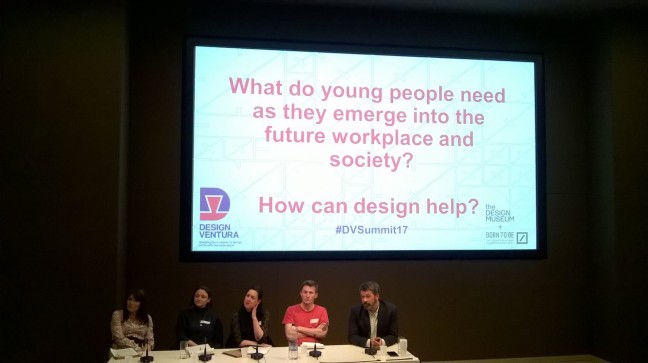
Brexit and the EBacc – a pairing that sounds more like a novelty music act from the 1970s than a confluence of misfortunes – were subjects that couldn’t be avoided. The Government’s Industrial Strategy Green Paper came up in discussion a few times. Published in January, it sets out planning for the UK’s economic future once we have left the EU. Organised around 10 pillars, the ‘developing skills’ priority was considered pertinent to design education and its value to the economy. One speaker also mentioned Brexit Design Manifesto, produced by Dezeen magazine, which is worth a look.
The sharp decline in pupils studying Design and Technology at GCSE level was a particular cause for concern during discussions. The Design and Technology Association (DATA) spearheaded a campaign last year to raise the profile of the subject. Their short film What is Design & Technology – and why do we need it?, made a connection between the investment in D&T in the 1990s and the pay-off over the following decades as those pupils then thrived and built careers in the creative industries. We risk cutting off the pipeline of new talent when design (either through D&T or Art & Design) is cut from a child’s education.
So far, so sadly familiar – the drop in D&T has been a topic of discussion for some time now. What I found more interesting was hearing another perspective on the issue. Holly Donagh from A New Direction framed the EBacc discussion in relation to inclusion agendas. Pupils who graduate with at least five GCSEs will go on to have greater social mobility and more career opportunities than those who don’t. The aim of the EBacc is to get 90% of pupils achieving five GCSEs; whereas the current figure is closer to 35-40%. Living in my leftie echo-chamber, I only ever hear about how awful the EBacc is. Of course it makes sense that those on the other side of the fence also want a high quality education for the next generation – we just have very different views on the role of art and design in achieving that (I should add that Holly was presenting another perspective for the purposes of a group discussion, rather than arguing against design education). Both sides in this debate are deeply entrenched and Holly’s comments made me realise that a greater insight into each other’s rationale would surely help find some middle ground.
And finally, there was plenty of discussion around career pathways for young people. It’s one thing to be at school, and it’s another thing to be established in a career – but getting from A to B is incredibly daunting when you’re 16 and don’t know what you want to do with your life. A huge range of jobs rely on creative skills, and the creative industries are stuffed with a variety of careers, but these opportunities are not well-known. If young people (and their parents) were better informed about what was possible and available, the value of design education would be better understood. The Sorrell Foundation has created the online resource, Creative Journeys, to meet just that purpose. And I should also mention Creative Quarter and Making It are two large careers’ festivals for young people that the V&A’s Learning department run each year.
Another of NESTA’s projects involves sifting through a mountain of online job advertisements to identify the careers that require creative skills. They have sifted through 33 million online ads (promoting UK jobs, dating from 2011-16) and identified 12,000 unique skills. From this data, they have arranged creative skills into five broad categories – Tech, Support, Selling, Creating & Designing, and Teaching. The final resource is still being tested, but it will ultimately provide an online facility whereby a young person can identify their skills and interests and match them to a range of possible career options.
The jobs-market isn’t what it used to be. My own career pathway – from administrator to assistant education officer to education officer to management – feels very old-fashioned when I read the CVs of twenty-somethings, dominated by internships, volunteering, placements and short-term contracts. A patchwork of experience now seems to be the norm. Perhaps not surprisingly, initiative and drive are key attributes in this working climate, and the top buzzword of the day – entrepreneurship – is becoming increasingly important.
Julio Terra from Kickstarter gave one of the keynotes and offered great insights into this new world of work. He recommended designer Craighton Berman and his interest in ‘design entrepreneurship’, championing how designers can work more independently and sustainably. Julio also mentioned ‘D2C’, the designer-to-consumer model, made possible through digital technologies that cut out the middlemen of distribution. And of course Kickstarter itself is changing the game for how new products are backed and launched. I can’t quite believe the company was founded as recently as 2009 – it feels like it’s always been there. In this model, storytelling and narrative have usurped conventional marketing. Young designers are attracting backers through engaging and personal short films to promote their work, made using readily available software.
This brave new world of employment has a rich assortment of pitfalls and opportunities, many of which – for good and bad – are the result of new technologies and a splintered job market. While we need new thinking around education and training to keep abreast of these rapid changes, the path to success remains the same – find something you’re passionate about, word hard, network, and be good at what you do.
Source: https://kiwilooseinmuseums.wordpress.com/2017/04/03/design-ventura-summit-adventures/
-
What do young people need as they emerge into the future workplace?
The Design Ventura summit “Design: the problem and the solution” was held on 29 March 2017. Its purpose was to bring together educators, designers, cultural providers and policy makers to discuss how they can ensure that young people are developing creativity, design thinking and employability skills to prepare them for future success.
The following extract is by Harry Trimble, Designer for Service Manual and Patterns Government Digital Service, on his take on the issues discussed.
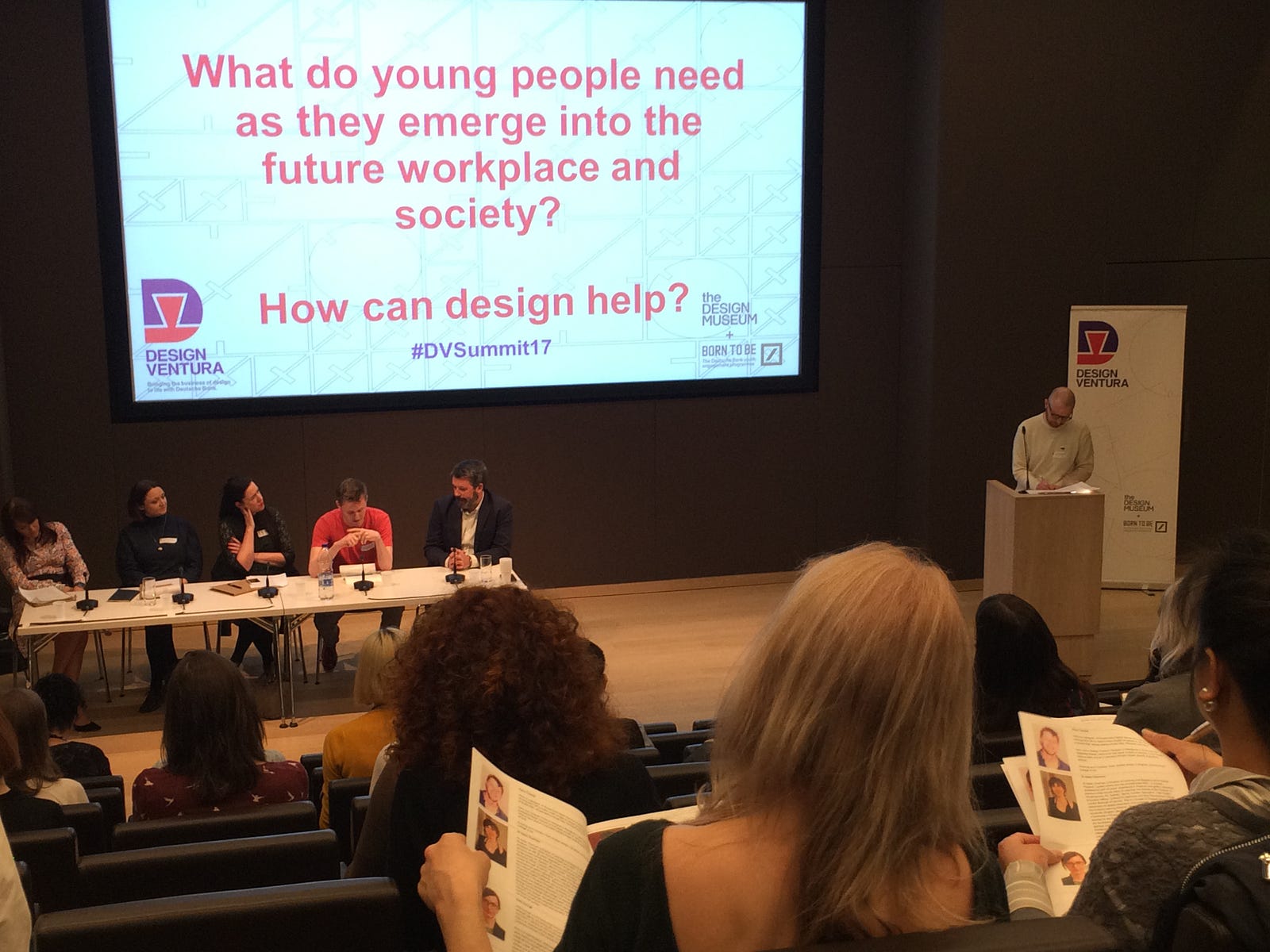
I spoke at the Design Museum on Wednesday, for its design education conference. I was in a panel with some nice people, doing interesting, important things. We spoke for 5 minutes each, then answered some questions.
Here’s what I said:
Hello. I’m Harry. I work on GOV.UK, designing public services.
I only got asked on Friday to come speak here, so apologies if what I’m about to say sounds a little disorganised, raw or even ranty.
Also I’ve framed what I’m about to say in the context of education, rather than about “design”, as that seems a little specific and design is just about problem solving anyhow.
So to answer the question we been given: ‘What do young people need as they emerge into the future workplace, and society? How can design help?’
First we need to focus on learning, not institutions.
From schools to universities to inspectors to workplaces. Institutions are obsessed with themselves and the things they care about. Needless, formal things like testing, exam results, assessment reports and performance reviews. Which are there to make institutions look good. Let’s be honest that doesn’t meet the needs of their users.
Even despite all this measurement, we don’t measure the things that do matter in learning. The outcomes of which can only be observed over years and decades, not weeks and months. For example schools success should measured not by exam results, but how they’re students are doing years after they leave. What jobs they do. Can they adapt to new jobs. How happy they are.
The best learning now is happening on the fringes of institutions. In school code clubs, meet-ups and competitions like Design Ventura. Learning to work in teams, think through making, test ideas and explain your decisions. All things that will help in most careers in the future, not just design. So the more young people who are able and comfortable to do this, the better.
This learning is less formal. It’s more relevant. It’s more agile. It exists to meet young people needs, which institutions are either too slow or unaware to do.
This takes me onto my second point;
Stop teaching people things computers can do. I’ll repeat myself. Stop teaching people things computers can do.
So I don’t mean reading, writing, maths and increasingly coding, which are foundational skills for all learning.
But much of the formal stuff we teach young people are things computer can and will do better: recalling facts and performing standardised processes. We are preparing people for careers that will, if they aren’t already, being automated away. Automated away into history.
Also just as an aside, many of the jobs that are being automated are ones people hate doing anyway.
What we should be doing is teaching young people problem solving, question asking, collaboration, empathy and the ability to learn new things continuously. Things which computers on the whole suck at. Much of our prosperity in the future will be depend on how many people can do jobs computers can’t.
Much of the education systems we have now is still Victorian. As journalist Tom Goodwin said ‘It’s staggering to me as to how much the world has changed, and how little education has.’
We need education for the future. It needs to look like this.
Education will be of the internet, not just on it.
The internet is not about computers, it’s about people.
Education in the future will fully embrace the culture of the internet: it will be more open. More collaborative. More distributed. And more adaptable to change.
This is already happening in some places.
Teachers are collaborating on lesson plans over Facebook. They are meeting on things like Design Ventura’s teacher training, where they can share their enthusiasm about teaching design. This point is the super important: the world can never have enough enthusiastic teachers.
Having networks of enthusiastic design teachers is a powerful thing. Bringing people together around a shared interest is a powerful thing. The internet is great for this.
Another example is Code Club, where thousands of volunteers are teaching kids to code. If you want to set up a Code Club, all you have to do is go online, download the tools and find a room to host it in.
Because it’s a centrally-run resource it can be updated regularly. Meaning the things the children learn is as up-to-date as possible. The internet is great at this too.
Recently at work, we ran a day for degree students interested in design in the public sector. Students came from London, Glasgow, Copenhagen, Berlin and even Buenos Aires. This took nothing more than a blog and Eventbrite to organise.
These examples hint at what education can and needs to be. Hands-on. Project based. Networks of enthusiastic teachers. Open-source curriculums adaptable to change. Backed up by skilled volunteers. Enabled by internet culture and infrastructure.
The world is fast and not short of problems. Education can and should be equal to it.
Thanks.
Source: https://medium.com/@HarryTrimble/design-ventura-summit-241ec7cf5c93
-
Working as a high performing team – some tips
A big part of your experience of Design Ventura is the opportunity to work like a professional design team. In this blog, I want to share some ideas about this to help you make the most out of this opportunity – and to set you all a challenge to be a really high performing team.
What is a high performing team?
Here’s a simple picture describing some of the features of a high performing team.
Clear sense of purpose:
Be clear on why the team exists and what you are there to achieve as well as how you are going to work together. In the team I am currently in, we have a motto or logo: One team, one dream. It’s a way of pulling us all together. Maybe create one for your team to help build that sense of common purpose?Clear about roles:
You’ve been asked to pick roles in the team. What’s really important here is that everyone knows what their role is and that you all trust each other to get on with that role. It might be nice to share the roll of team leader role to give everyone the opportunity and experience of doing this.Get the job done:
High performing teams keep going and help each other out.
This is about turning up on time, pulling your weight even when the going gets tough. You will have good times and bad times to work through.Value differences:
This is my favourite part of being in a team – learning to work with other people. Be open to the skills others bring to the team and don’t be afraid to be yourself.Final take away: Team Reflection Time
A couple of simple questions to use at the end of every working session together:- What’s going well?
- What could we be better at?
Don’t let things go on for too long if it isn’t working well – it’s up to everyone on the team to take responsibility to say if something isn’t working or could be improved. Put the team first, invest your energy in making the team be the best it can be.
In the words of Steve Jobs, Apple’s extraordinary founder, “the journey really is the reward.” Make the most out of working with your team mates, take something away from every session you have, show up, contribute, share, be the best team mate you can be– and really enjoy it, something magical can really happen when you are part of a high performing team.
If you want to go fast, go alone. If you want to go far, go together.
– African proverbWritten by Siobhan McKavanagh, Organisation Design Specialist, Risk Division – Deutsche Bank
-
Photographing your product or prototype
As you begin to prepare your Design Sheets for entry to the Design Ventura competition, you will invariably be thinking about how you are going to present your ideas visually. Drawings work really well to show your design concept, and diagrams and technical illustrations to accompany your written explanations will show exactly how your product works.
A prototype/mock up of your product is a great way of showing our judges how your design will work and how it will look, so please make sure you include photos of these prototypes if you can. Here are some tips for taking a great product photo:
Natural Light
Set up a table near a window for your photoshoot – sun diffused through cloudy skies or a white sheet makes an excellent setting for a product photo. Really bright direct sunlight or a camera flash create strong dark shadows and make products look less attractive.Background
Use a big piece of paper or a plain colour piece of cloth as your background to make your product really stand out. To create a seamless sweeping backdrop, stick your piece of paper to the wall and drape it over the table in front and then place your product on top.
Learn how to create a seamless backdrop in this tutorial from Fstoppers.
Tripod
Set your camera or phone up on a tripod to make sure the image won’t be blurry. If you don’t have a tripod, improvise! Find a place to rest your camera and use the timer setting to make sure the photo isn’t affected by shaky hands. Sometimes, even a steady hand can create a blurry photo, so find away to rest your camera securely on the table for the optimum shot.Perspective
To really help the Design Ventura judges understand your design, it is a good idea to take photos of your product from a couple of angles. If it opens, show it open and closed. If it has a great design on the other side, make sure to take a photo of that.
Photos are a great way of telling your products story – Globe Academy’s Design Ventura entry for a foldable plate, Dish Dash, used photographs to help explain how the product worked.
-
What’s in a (brand) name?
Picking a good brand name is an important part of developing your product’s brand. A good name will help your customers identify and differentiate your product from others. Your products name should be easy to notice and recognise, with a clear and obvious meaning. You should not need to explain what the name means or why it has been chose. It should be selected very carefully as it captures the key theme of a product in an efficient and economical manner.
Brand names are not necessarily associated with the product. For instance, brand names can be based on places (Air France, British Airways), animals or birds (Red Bull, Dove soap, Puma) or even people (Victoria Beckham, Alessi).
A check list for a good brand name
Is your brand name:- Unique and distinctive?
- Easy to pronounce, identify and remember?
- Representative of your product’s qualities and benefits?
- Suggestive of what the product does?
If you have time
You could conduct consumer research to see what your target market thinks of your brand name. It is important that when they see or hear your brand name, they are able to identify what the product is and does and they should be able to pick up on any key messages you wanted to convey. It would be helpful for you to give them an idea of the price and to show them the product, so that they understand the purpose of the brand name and the context in which it will be used.You may also want to consider if your brand name is easily convertible into foreign languages, and whether it would portray negative or wrong meanings in other categories. For instance NOVA is a bad name for a car, in Spain, because in Spanish it means “doesn’t go”.
-
How to make your product stand out
What is a product?
A product is a thing or a service that is sold to customers or other businesses. Customers usually buy a product to meet a need, as a result when a product is designed it is important that the requirements of the customer (the target audience) are carefully considered.
What is product differentiation?
Product differentiation determines how a product is made to stand out from other similar products, and it uses that difference to drive customer interest and sell the product. Product differentiation can be as simple as packaging the goods in a creative way, or as elaborate as incorporating additional features.
Throughout the design process, the function, appearance and cost of the product need to be considered in relation to the target audience to ensure that it will appeal to the target market.
How product differentiation is created:
- Establishing a strong brand image(through packaging and logos)
- Emphasising the unique selling point (USP), this can be done through the use of a product tag line
- Offering better, features, functions, design, appearance or selling price than rival products.
-
Thinking about product packaging
Packaging makes up an important part of your product. It does the following things:
- contains and holds the product
- protects the product from damage
- informs the customer about the product
- helps to create a brand identity to promote and sell the product
- makes it easier to carry, use and store the product
Cardboard containers are the most common type of packaging. The process involved in manufacturing a cardboard container is:
- Print the design onto card
- Cut out the shape of the carton, with tabs for gluing
- Fold the net into the container shape
- Glue the container together along the tabs
Other types of packaging to consider:
- Bottles and jars made from glass or plastic are used for liquids, granules and powders.
- Plastic bags are used for food products and small loose items, e.g. snack foods and sweets.
- Cans are used for food products. Drinks cans are made from aluminium and food cans are made from tin-coated steel (tinplate).
- Bubble packs consisting of a stiff plastic bubble made by vacuum-forming fixed to a card backing – are used for small products, e.g. stationery items, toys and screws.
- Shrink-wrapping– soft plastic vacuum formed onto card backing – is used for some small products, e.g. DIY products and toys.
Packaging regulation
The information given on packaging is regulated by laws and standards. Some of the most important principles are that:- the name of the company that made the product should be visible on the packaging. This is required by law.
- the contents of the product (and its packaging) should be listed. This is required by law.
- health and safety information about using the product should be given. This is required by law.
- information about safely disposing of the packaging or container after use should be given.
- a bar code should be displayed for stock control and pricing purposes.
- instructions for recycling the product and/or its packaging after use.
-
How to attract your target audience through design
Hopefully by now you’re well on your way to developing and refining your chosen ideas. During my school workshops I saw some really good beginnings of drawn and sketched designs. Here is my advice on how to use design to attract your chose target audience; consider this both from your product and a packaging design perspective.
My two key areas I will talk about here are ‘colour’ and ‘packaging’. I’ve picked a few examples of projects as reference for you. One thing to note on both of these areas is to keep things simple; the more complicated you make the look of your designs and packaging, the less chance your audience is going to want to pick it up in the Design Museum’s shop and, ultimately, buy it.
Colour
There are many ways to use colour in your designs and packaging, so try out plenty of options.Colour can be a tricky area for designers as colours can mean different things to different people and not all colours are effective as when you would expect them to be. For example, pink is a colour traditionally known to appeal to a female audience, but take a look at what cycling brand Rapha have done to utilise pink in their packaging, which mainly attempts to appeal to a male audience. The subtle use of the pink makes the products feel premium and looks well designed; not all use of colour has to be bold.

On the other hand, a bold single colour on your designs and packaging can help your product stand out against others on the shelf. Take a look at how food brand Makers & Merchants brand and package their products; simply just with the use of a bright red colour which is striking and looks appealing.


Packaging
By not over complicating your packaging, your audience will quickly and easily be able to see your product and figure out its function.When designing your product’s packaging, think about how much packaging is actually needed. You will have spent lots of time designing and refining the actual look of your product, so perhaps minimal packaging could be used to attract your audience in the Design Museum’s shop.
A few great examples of this are firstly from Mustang jeans, who actually used their jeans as the outer wrapping when a customer ordered a pair from their online shop.


Secondly, take a look at the Turbo Flyer toy, a wooden snap-out aeroplane toy which is housed in minimal packaging which reflects the design of the product itself.



By Industry Expert Paul Jenkins
-
Ask the Expert – developing design and business ideas
Emilie: Expert Panel, do you have any final tips to share with teachers and students about developing designs and business ideas?
Emilie: Or any final questions from Catherine from schools?
Harry T: Only try help your students understand how important enthusiasm is in the pitch. If you think you’re idea is awesome, likelihood is others will.
Catherine RS: Another question from Fitzwimarc School, for Christoph and Steven. What are the special qualities of past winning products?
Steven Preston: All of the previous winners took something that was already familiar and gave it a unique twist; it was that creative re-imagining that added value and ultimately made their designs successful. I should also point out that each DV winner so far has been commercially successful in the shop
Emilie: Yes there are lots of resources to help you on the website www.ventura.designmuseum.org
Chris Garcin: I think the discussion has raised some of the tips I was going to pass on – keep it simple, have the brief, or theme at the centre of an idea, think who goes to the Design Museum shop and what they would buy, explore ideas by sketching, get into rough models to try out ideas, have conviction in your idea and have fun!
Komal: For those schools unable to visit the museum, we have lots of helpful blog posts from our Industry Experts.
Catherine RS: That’s a great observation Steven, which I’m sure will be very useful to students. Successful ideas need to be unique, but also have something familiar that attracts customers.
Christoph Woermann: There is no easy answer for special qualities that make a product pass straight over the finishing line. It is always a mixture of the creativity of the idea, the simplicity of its realisation, the commercial viability, a fun factor in having it, its uniqueness etc.. Never forget though that the presentation in the pitch is a unique chance to make to stand out. In the past we have seen social media campaigns, theatre performances, free prototypes and above all great fun with the pitching teams. This is an important part in the whole process, too. Hope that helps as a pointer.
Emilie: Great point Christoph thanks, believe in your idea and go for it
Catherine RS: Thanks Christoph – that’s enormously helpful. The competition is getting harder and harder, so ALL of the top ten ideas are potential winners, and it’s the personal conviction of the students alongside the idea that helps to push it through!
Catherine RS: That’s it from me! My closing tip is to refer to the original brief and the judging criteria as you refine your idea and get ready to pitch in school.
Emilie: What a fantastic web chat! Thank you all for joining us this afternoon, and sharing questions and expert advice.
Emilie: Sadly we have run out of time
Chris Garcin: Good luck students!
Paul Jenkins: Thanks everyone, I hope I’ve been of some help! Good luck students!
Harry T: Thanks for coming everybody. Best of luck with the rest of the competition. Maybe meet some of you at the celebration in the Spring.
Christoph Woermann: To all the teams that participate in this year’s challenge: To take part already makes you a winner because you will learn a great deal about teamwork, meeting deadlines, operating a small business and realising that everything you really want will also happen. Good luck, you can all make it to the final round and remember, the design museum and the designers get always inspiration from you all.
Emilie: our final chat will take place on Thursday 6 November 2014 at 3.30pm, on Chatzy, where we will share advice on: FINALISING IDEAS, PRESENTING AND SUBMITTING ENTRIES
Emilie: Until then best of luck to all the students and teachers taking part, and thank you again to our Industry Experts for joining us and don’t forget submission date is 12 November 2014! Good luck again!
-
What makes a good idea great?
Enterprising ideas: Simple ideas with big appeal – what makes a good idea great?
Explaining what makes a good idea great is tricky, first it’s understanding what makes a an idea ‘great’ in the first place.
Personally, I think it’s an idea which makes you smile, it captures your full attention, you immediately ‘get it’, you value it’s cleverness, usefulness or sheer beauty.
You don’t have to be an experienced designer to hit upon a great idea, the process gets easier with experience, years of brain training! But with applied dedication, curiosity, perseverance and imagination anyone can come up with that winning idea. It’s all about having an open, enquiring mind. And, the time to properly consider and develop your thinking into strong concepts.
Remember, everything’s been done before, it’s about learning from what’s been done and making things even better. A completely innovative, fresh new idea will always stand out, that’s what you should strive for.
To be really ‘great’ the idea really has to answer the brief in the most succinct way, the simpler the better.


